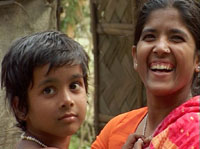
Grades 7-12, College, Adult
Directed by Subina Shrestha & Alex Gabbay
DVD Purchase $79, Rent $45
US Release Date: 2005
Copyright Date: 2004
DVD ISBN: 1-59458-180-0
VHS ISBN: 1-59458-179-7
Subjects
Asian Studies
Developing World
Education
Global Issues
Health
Human Rights
Humanities
International Studies
Millennium Development Goals
Population
Poverty
Reproductive Rights
Social Justice
Sociology
United Nations
Women's Studies
Staying Alive!
Poverty combined with lack of education and health services affect maternal mortality rates in Bangladesh.
 |
Life visits Bangladesh to find out how the country is planning to cut the maternal mortality rate by three quarters by the year 2015. Every year, a recent WHO report shows, 529,000 women worldwide die in childbirth and pregnancy. Nearly all of these preventable deaths occur in developing countries, where problems of poverty, combined with lack of health and education services, make motherhood a dangerous undertaking. For over 20 years, the international community has pledged itself to improving maternal health. But until recently there has been very little progress. Now, in the Millennium Development Goals, 189 countries have renewed their commitment to reduce maternal mortality by 75 per cent by 2015. In Bangladesh, 50 women die during pregnancy or in childbirth every day. Will Bangladesh be able to deliver its promises to cut maternal mortality figures by three-quarters by 2015.
The other titles in the series are:
1. The Millennium Development Goals: Dream or Reality - Explores the ambition and scope of the UN's Millennium Development Goals, and the obstacles to their achievement.
2. The Real Leap Forward: Scaling Up Poverty Reduction in China - Reports on China's successful efforts to reduce poverty through development and targeted programs.
3. Listen to the Kids! - A Unicef intitiative involves children in decisions that affect their own futures, their families and communities.
4. Helping Ourselves! - In India, two community projects help people move out of poverty and gain control of their lives.
5. Reaching Out to the Grassroots - Education and community-driven development combat poverty in Bangladesh and Indonesia.
7. When the Cows Come Home - Despite the success of the "Jamaica Hope" milk cow, Jamaica's dairy industry is facing a crisis, as EU trade undercuts island production.
8. The Coffee-Go-Round - Many coffee-producing countries like Ethiopia are facing economic disaster even as the demand for coffee increases world-wide.
9. Aiming High - Focuses on Uganda's successful economic recovery in the wake of Idi Amin's regime.
10. Whose Agenda Is It Anyway? - To fulfill the Millennium Development Goals, many poor countries are now implementing "Poverty Reduction Strategy Programs".
11. Geraldo's Brazil - Five years later, Life rejoins a Brazilian factory worker affected by the globalized economy.
12. Yemeni Futures - More than a decade after its unification, Yemen is still struggling to improve the standard of living.
13. Crisis Control: Stemming the Spread of HIV/AIDS - Ukraine's emerging HIV epidemic is contrasted with Africa's longstanding HIV/AIDS catastrophe.
14. Educating Yaprak Turkey's ambitious campaign to reduce poverty includes convincing reluctant parents to send their daughters to school.
15. Brazil's Land Revolution In the state of Bahia, a new initiative encourages the landless to band together to buy up land -- with low-interest government loans.
16. How Green Is My Valley? Documents efforts to revitalize the polluted, impoverished communities in the former coal and steel producing valleys of South Wales.
17. Warming Up in Mongolia Unless sustainable alternatives are introduced, Mongolia's dependence on fossil fuels and rapid urbanization threatens the environment.
18. This Hard Ground: Remembering the Displaced Civil war leads to the internal displacement of millions in Sri Lanka.
19. Blue Danube? Connecting more than 18 countries in Western Europe, the Danube River is at the heart of a dilemma over shared resources in the growing European Union.
20. Between War and Peace The United Nations Peacekeeping Mission in Liberia encourages combatants to turn in their weapons and wage peace.
21. Reel to Real: Balancing Acts Explores the international movement for women's rights.
22. Reel to Real: Holding Our Ground International efforts to assure reproductive health and rights conflict with cultural realities in the Philippines, Latvia, Japan, and India.
23. Return to Srebrenica Survivors of the massacre in Srebrenica struggle to heal their community and build a new future.
24. In The Wake of War A burgeoning grassroots peace movement in Burundi is aimed at ending civil war between the Tutsis and Hutus.
25. Returning Dreams In the aftermath of Liberia's civil war children are fighting to reclaim their futures and return home.
26. The Hospice Workers at the Mother of Mercy hospice in Zambia provide palliative care for those afflicted with AIDS.
27. Slum Futures The slums of Mumbai are an important microcosm of how slums are developing around the world.
Reviews
"The importance of these films is that they are intended to raise awareness about global issues in young people, and can be used by anyone for this purpose. The quality of the films is excellent. They are documentaries about the U.N. Millennium Development Goals and include brief interviews with people who are actually involved in MDG programs, from various institutions and from the grassroots to executive level...The objective evidence about the current global crisis of insecurity, poverty, gender inequalities, environmental degradation, and lack of international cooperation is presented in a way that is both realistic and non-inflammatory.
Children are the future. Educational materials such as the Bullfrog Films are very important for the future of both humanity and the human habitat...The Bullfrog Films certainly can and should be shown to children, especially to high school students. But these films are most appropriate for those who prepare the children for responsible citizenship, including global citizenship. They are certainly appropriate for parents who want their children to know about the need for human solidarity and environmental sustainability. And, they are most appropriate for training teachers to plant the seed of global concerns in their students' minds and hearts."